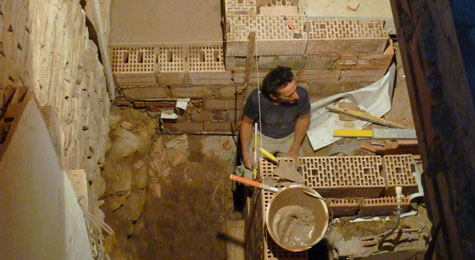 |
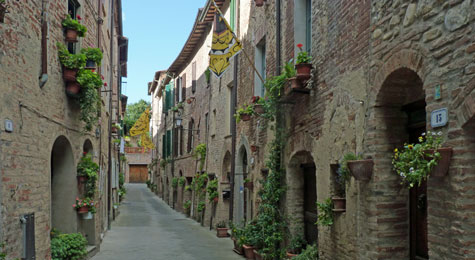 |
|||
CdP
14 August 2016
The point where you enter your building site and find things are going up, rather than being pulled loudly and dustily down, is a joyous one. It happened to me the other day at my project in town: just a couple of bricks (am I clutching at straws?) but oh, what a nice feeling.
It was accompanied by another big hole – a worrying one this time. The stone and brick wall between my house and the one next door rests – we have now discovered – on more or less… nothing. Just a bit of beaten earth, much like the whole western wall of our home here, which had to be dismantled and put together again where it couldn’t be shored up, and rebuilt from the base down.
You don’t have the dismantling luxury in a long row of adjoining houses of course. And hopefully the house on the other side is still resting on its nice solid base with undisturbed earth shoring it up solidly. But on my side we’ve excavated away for the new steps up from the cellar, and the bricks and stones of the wall above are beginning to look distressingly loose.
The builder has shored the whole thing up with a picturesque arrangement of scaffolding pieces and odd wooden planks. And he’ll no doubt weave it back together again as he fills it all in with the new steps. What I’m mostly seeing in that hole right now is a whole lot more money owing for yet another little extra task. Of course I know from expensive experience that you don’t mess about with ancient constructions without incurring untold amounts of unexpected expense. But I might try playing the lottery a little more assiduously.
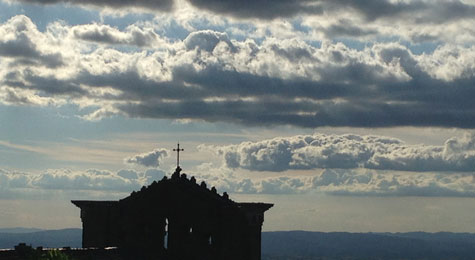 |
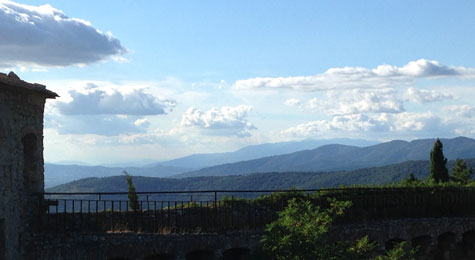 |
|||
Summer and visitors have been propelling us out, and forcing us to catch up with things we should have done and seen long ago.
When we set out for the Cortona photography festival I realised that I’d never been up to the high part of the town. How can that be? How many times have I been to Cortona?
I tend to avoid the lower reaches during the summer season, when they’re filled with Frances Mayes wannabes – a particular brand of late-middle-aged American woman, less-than-thrilled husband in tow, with a light in her eyes that’s somewhere between wonder and baleful disillusion.
But right up at the top, below the fortress where several bits of the photography show are housed, Cortona is quite another thing: gorgeous little medieval lanes, and low stone houses with vegetable gardens against a backdrop of the city walls, parts of which claim to be Etruscan. The squat church of San Niccolò has a Deposition by Luca Signorelli – not one of his best but lovely nonetheless, with a Madonna and child plus Saints Peter and Paul on the back. There’s also a strange little sketch by Gino Severini. Both were Cortona natives.
In the fortress itself, you can walk the ramparts. The view is exhilarating. We went on a day of clean wind gusting clouds across a blue blue sky. You felt like you could see clear to the Adriatic.
Closer to home, I finally went to see our Etruscans. In my own defence, I should say they have been locked away and off limits for months, but for August they’re on show with commentary by the four enterprising young women who convinced the authorities that they should be given the right to excavate.
In the crypt of Santa Maria dei Servi are two sarcophagi and four ash-caskets, each of the latter with the deceased depicted in jolly feasting, reclining little sculptures on their lids. One is so worn that I gazed at it for ages before spotting the shadow of an elbow bend.
It’s a tale of initiative (by the archeologists) and determination (by the town council) and hopeless underfunding. The regional heritage office had no one to send to work on the newly discovered tomb. These recent archeology graduates – all of them local, all female – offered to take the project in hand. I didn’t dare to ask whether or not they had been paid for their efforts though I presume that if they were, it may have been little more than token. Also involved were some council workers and some firemen, all labouring on their own time. And if they hadn’t made the effort? I suspect the tomb may have been abandoned with ‘keep out’ signs and some tatty orange plastic fencing around it for a long long time.
The local council has fought to keep ‘our’ Etruscans in situ. But the smaller items from the tomb (crockery, a bronze jug with an elaborate handle, a strigil) are away in Florence – restored and ready for display but unable to return home because the council can’t afford suitable display cases. Neither can it afford to €3000 needed to open and restore the second sarcophagus. (The lid of the first was already cracked when it was found, so the skeleton of unusually tall character Laris Pulfna – his name is inscribed on the stone casket – was immediately visible and his skull is off somewhere having its DNA examined.)
The police ‘experts’ summoned to search for further tombs turned up with equipment for locating masonry structures, not realising that tombs tend to be underground affairs, carved into soft tufa-like rock; they have never returned with the right kit.
But despite penury and a bit of slapstick, there’s something very moving about these Etruscans with their bulging tummies and their very real-looking faces. There’s none of the elegance and wonder of more sophisticated painted Etruscans in Tarquinia, or sculpted ones in Villa Giulia and the like. These are earthy and very approachable.
And they're likeable too, which makes me feel I should be donating. The extremely admirable Art Bonus scheme means that we can all do so easily, and detract 65 percent of anything we give from our taxes (for those of us who pay taxes in Italy).
But I’m also thinking about that hole in my 13th-century wall, and how much it’s going to cost me to patch it up properly. Poor old Laris Pulfna is going to have to wait a little longer before I give him any of my money.
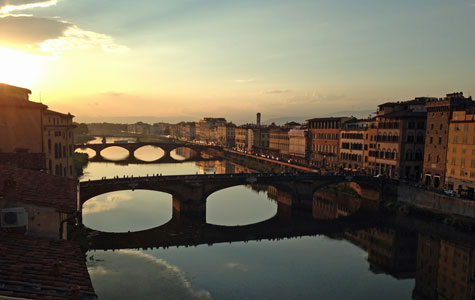 |
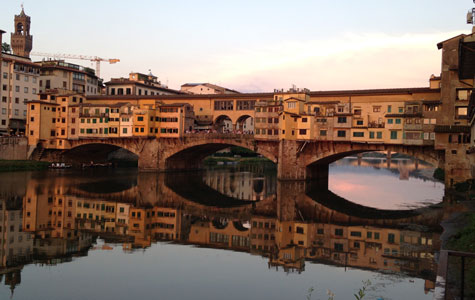 |
|||||||
A jaunt to Florence, a spectacular sunset, courtesy (the former) of Lungarno Collection's Borgo San Jacopo and its Spoon dining initiative. |
||||||||
| BACK | ||||||||